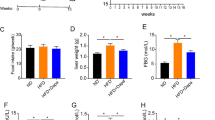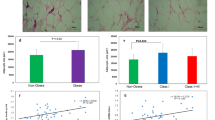Abstract
Obesity is a complex, chronic disease that arises according to the interaction between genetic and environmental factors. The expansion and growth of white adipose tissue (WAT) could be related to angiogenesis. Resveratrol and adrenomedullin (AdM) were used for the inhibition of angiogenesis in metabolically passive WAT for inhibiting the expansion of this tissue, and the activation of angiogenesis in metabolically active brown adipose tissue (BAT) for increasing daily energy consumption as a way of reducing obesity. Rats were divided into eight groups. Four obese groups were fed with a high-fat diet containing 60% fat as energy for three months. After obtaining obesity, 2.5 nmol/kg AdM and 10 mg/kg resveratrol were treated to experiment groups intraperitoneally (i.p.) every other day for four weeks. AdM and vascular endothelial growth factor A (VEGF-A) mRNA levels were detected with semi-quantitative PCR; protein levels were detected with Western Blotting. AdM and resveratrol are multifactorial molecules, thus, this study has revealed a few novel evidence. The results were distinct in the group and treatment levels. The results showed that resveratrol has a role in angiogenesis in obesity and contributed to AdM production. It is observed that AdM has regulated its expression and increased the effect of resveratrol in WAT. AdM and VEGF-A gene expressions could not be detected in BAT; however, it is suggested that resveratrol may have a pro-angiogenic effect in BAT of obese rats according to the protein levels. AdM also has regulated VEGF-A level according to the metabolic situation of the organism.


Similar content being viewed by others
References
Frühbeck G, Becerril S, Sáinz N et al (2009) BAT: a new target for human obesity? Trends Pharmacol Sci 30:387–396. https://doi.org/10.1016/j.tips.2009.05.003
Miao C-Y, Li Z-Y (2012) The role of perivascular adipose tissue in vascular smooth muscle cell growth. Br J Pharmacol 165:643–658. https://doi.org/10.1111/j.1476-5381.2011.01404.x
Cao Y (2007) Angiogenesis modulates adipogenesis and obesity. J Clin Invest 117:2362–2368. https://doi.org/10.1172/JCI32239
Zygmunt M, Herr F, Münstedt K et al (2003) Angiogenesis and vasculogenesis in pregnancy. Eur J Obstet Gynecol Reprod Biol 110:S10-8. https://doi.org/10.1016/S0301-2115(03)00168-4
Risau W (1997) Mechanisms of angiogenesis. Nature 386:671–674. https://doi.org/10.1038/386671a0
Folkman J (2006) Angiogenesis. Annu Rev Med 57:1–18. https://doi.org/10.1146/annurev.med.57.121304.131306
Ferrara N (2002) VEGF and the quest for tumour angiogenesis factors. Nat Rev Cancer 2:795–803. https://doi.org/10.1038/nrc909
Ferrara N (2001) Role of vascular endothelial growth factor in regulation of physiological angiogenesis. Am J Physiol Cell Physiol 280:C1358–C1366. https://doi.org/10.1152/ajpcell.2001.280.6.C1358
Kitamura K, Kangawa K, Kawamoto M et al (1993) Adrenomedullin: a novel hypotensive peptide isolated from human pheochromocytoma. Biochem Biophys Res Commun 192:553–560. https://doi.org/10.1006/bbrc.1993.1451
Martinez A, Miller MJ, Unsworth EJ et al (1995) Expression of adrenomedullin in normal human lung and in pulmonary tumors. Endocrinology 136:4099–4105. https://doi.org/10.1210/endo.136.9.7649118
Samson WK (1999) Adrenomedullin and the control of fluid and electrolyte homeostasis. Annu Rev Physiol 61:363–389. https://doi.org/10.1146/annurev.physiol.61.1.363
Li Y, Totsune K, Takeda K et al (2003) Differential expression of adrenomedullin and resistin in 3T3-L1 adipocytes treated with tumor necrosis factor-alpha. Eur J Endocrinol 149:231–238. https://doi.org/10.1016/j.regpep.2005.07.006
Nambu T, Arai H, Komatsu Y et al (2005) Expression of the adrenomedullin gene in adipose tissue. Regul Pept 132:17–22. https://doi.org/10.1016/j.regpep.2005.07.006
Allaker R (1999) An investigation into the antimicrobial effects of adrenomedullin on members of the skin, oral, respiratory tract and gut microflora. FEMS Immunol Med Microbiol 23:289–293. https://doi.org/10.1016/S0928-8244(98)00148-5
Sugo S, Minamino N, Shoji H et al (1995) Interleukin-1, tumor necrosis factor and lipopolysaccharide additively stimulate production of adrenomedullin in vascular smooth muscle cells. Biochem Biophys Res Commun 207:25–32. https://doi.org/10.1006/bbrc.1995.1148
Fukai N, Yoshimoto T, Sugiyama T et al (2005) Concomitant expression of adrenomedullin and its receptor components in rat adipose tissues. Am J Physiol Endocrinol Metab 288:E56–E62. https://doi.org/10.1152/ajpendo.00586.2003
Kato J, Kitamura K, Uemura T et al (2002) Plasma levels of adrenomedullin and atrial and brain natriuretic peptides in the general population: their relations to age and pulse pressure. Hypertens Res 25:887–892. https://doi.org/10.1291/hypres.25.887
Amri A, Chaumeil JC, Sfar S, Charrueau C (2012) Administration of resveratrol: what formulation solutions to bioavailability limitations? J Control Release 158:182–193. https://doi.org/10.1016/j.jconrel.2011.09.083
Szabó G (2009) A glass of red wine to improve mitochondrial biogenesis? Novel mechanisms of resveratrol. Am J Physiol Circ Physiol 297:H8–H9. https://doi.org/10.1152/ajpheart.00471.2009
Sielmann EH, Creasy LL (1992) Concentration of the phytoalexin resveratrol in wine. Am J Enol Vitic 43:49–52
Baur JA, Pearson KJ, Price NL et al (2006) Resveratrol improves health and survival of mice on a high-calorie diet. Nature 444:337–342. https://doi.org/10.1038/nature05354
Rayalam S, Yang J-Y, Ambati S et al (2008) Resveratrol induces apoptosis and inhibits adipogenesis in 3T3-L1 adipocytes. Phyther Res 22:1367–1371. https://doi.org/10.1002/ptr.2503
Schwartz MW, Woods SC, Seeley RJ et al (2003) Is the energy homeostasis system ınherently biased toward weight gain? Diabetes 52:232–238. https://doi.org/10.2337/diabetes.52.2.232
Abizaid A, Gao Q, Horvath TL (2006) Thoughts for food: brain mechanisms and peripheral energy balance. Neuron 51:691–702. https://doi.org/10.1016/j.neuron.2006.08.025
Carey AL, Kingwell BA (2013) Brown adipose tissue in humans: therapeutic potential to combat obesity. Pharmacol Ther 140:26–33. https://doi.org/10.1016/j.pharmthera.2013.05.009
Gesta S, Tseng Y-H, Kahn CR et al (2007) Developmental origin of fat: tracking obesity to its source. Cell 131:242–256. https://doi.org/10.1016/j.cell.2007.10.004
Oberkofler H, Dallinger G, Liu YM et al (1997) Uncoupling protein gene: quantification of expression levels in adipose tissues of obese and non-obese humans. J Lipid Res 38:2125–2133
Stefl B, Janovská A, Hodný Z et al (1998) Brown fat is essential for cold-induced thermogenesis but not for obesity resistance in aP2-Ucp mice. Am J Physiol Endocrinol Metab 274:E527–E533. https://doi.org/10.1152/ajpendo.1998.274.3.E527
Grundlingh J, Dargan PI, El-Zanfaly M, Wood DM (2011) 2,4-Dinitrophenol (DNP): a weight loss agent with significant acute toxicity and risk of death. J Med Toxicol 7:205–212. https://doi.org/10.1007/s13181-011-0162-6
Brakenhielm E, Cao R, Gao B et al (2004) Angiogenesis inhibitor, TNP-470, prevents diet-induced and genetic obesity in mice. Circ Res 94:1579–1588. https://doi.org/10.1161/01.RES.0000132745.76882.70
O’Reilly MS, Holmgren L, Shing Y et al (1994) Angiostatin: a novel angiogenesis inhibitor that mediates the suppression of metastases by a Lewis lung carcinoma. Cell 79:315–328. https://doi.org/10.1016/0092-8674(94)90200-3
O’Reilly MS, Boehm T, Shing Y et al (1997) Endostatin: an endogenous inhibitor of angiogenesis and tumor growth. Cell 88:277–285. https://doi.org/10.1016/S0092-8674(00)81848-6
Hariri N, Thibault L (2010) High-fat diet-induced obesity in animal models. Nutr Res Rev 23:270–299. https://doi.org/10.1017/S0954422410000168
Harrold JA, Williams G, Widdowson PS (2000) Early leptin response to a palatable diet predicts dietary obesity in rats: key role of melanocortin-4 receptors in the ventromedial hypothalamic nucleus. J Neurochem 74:1224–1228. https://doi.org/10.1046/j.1471-4159.2000.741224.x
Woods SC, Seeley RJ, Rushing PA et al (2003) A controlled high-fat diet induces an obese syndrome in rats. J Nutr 133:1081–1087. https://doi.org/10.1093/jn/133.4.1081
Hwang ISS, Fung ML, Liong EC et al (2007) Age-related changes in adrenomedullin expression and hypoxia-inducible factor-1 activity in the rat lung and their responses to hypoxia. J Gerontol A Biol Sci Med Sci 62A:41–49. https://doi.org/10.1093/gerona/62.1.41
Li Y-Y, Hwang IS, WS O, Tang F (2006) Adrenomedullin peptide: gene expression of adrenomedullin, its receptors and receptor activity modifying proteins, and receptor binding in rat testis–actions on testosterone secretion. Biol Reprod 75:183–188. https://doi.org/10.1095/biolreprod.106.052274
Chen S, Chakrabarti R, Keats EC et al (2012) Regulation of vascular endothelial growth factor expression by extra domain B segment of fibronectin in endothelial cells. Investig Ophthalmol Vis Sci 53:8333–8343. https://doi.org/10.1167/iovs.12-9766
Untergasser A, Cutcutache I, Koressaar T et al (2012) Primer3-new capabilities and interfaces. Nucleic Acids Res 40:1–12. https://doi.org/10.1093/nar/gks596
Cheyuo C, Yang W, Wang P (2012) The critical role of adrenomedullin and its binding protein, AMBP-1, in neuroprotection. Biol Chem 393:429–439. https://doi.org/10.1515/hsz-2012-0103
Yurekli M, Culum AA (2016) The investigation of relationship between adrenomedullin vascular growth endothelial factor in obese and calorie restricted rats. Med Sci Discov 3:124–129
Lagouge M, Argmann C, Gerhart-Hines Z et al (2006) Resveratrol improves mitochondrial function and protects against metabolic disease by activating SIRT1 and PGC-1α. Cell 127:1109–1122. https://doi.org/10.1016/j.cell.2006.11.013
Eto T, Kato J, Kitamura K (2003) Regulation of production and secretion of adrenomedullin in the cardiovascular system. Regul Pept 112:61–69. https://doi.org/10.1016/S0167-0115(03)00023-5
Bertelli AAE (2007) Wine, research and cardiovascular disease: Instructions for use. Atherosclerosis 195:242–247. https://doi.org/10.1016/j.atherosclerosis.2007.04.006
Cao Y (2010) Adipose tissue angiogenesis as a therapeutic target for obesity and metabolic diseases. Nat Rev Drug Discov 9:107–115. https://doi.org/10.1038/nrd3055
Rupnick MA, Panigrahy D, Zhang C-Y et al (2002) Adipose tissue mass can be regulated through the vasculature. Proc Natl Acad Sci 99:10730–10735. https://doi.org/10.1073/pnas.162349799
Chen Y, Sheng-Hong T (2007) Review. Pro- and anti-angiogenesis effects of resveratrol. In Vivo 21:365–370
Distler JHW, Hirth A, Kurowska-Stolarska M et al (2003) Angiogenic and angiostatic factors in the molecular control of angiogenesis. Q J Nucl Med 47:149–161
Duarte D, Santos-Araújo C, Leite-Moreira AF (2011) Hypertension and angiogenesis in the aging kidney: a review. Arch Gerontol Geriatr 52:e93–e102. https://doi.org/10.1016/j.archger.2010.11.032
Arcondeguy T, Lacazette E, Millevoi S et al (2013) VEGF-A mRNA processing, stability and translation: a paradigm for intricate regulation of gene expression at the post-transcriptional level. Nucleic Acids Res 41:7997–8010. https://doi.org/10.1093/nar/gkt539
Ishii H, Oota I, Arakawa T, Takuma T (2002) Differential gene expression of vascular endothelial growth factor isoforms and their receptors in the development of the rat masseter muscle. Arch Oral Biol 47:505–510. https://doi.org/10.1016/S0003-9969(02)00033-X
Guidolin D, Albertin G, Spinazzi R et al (2008) Adrenomedullin stimulates angiogenic response in cultured human vascular endothelial cells: involvement of the vascular endothelial growth factor receptor 2. Peptides 29:2013–2023. https://doi.org/10.1016/j.peptides.2008.07.009
Evans JJ, Chitcholtan K, Dann JM et al (2012) Adrenomedullin interacts with VEGF in endometrial cancer and has varied modulation in tumours of different grades. Gynecol Oncol 125:214–219. https://doi.org/10.1016/j.ygyno.2011.12.429
Palmer BF, Clegg DJ (2015) The sexual dimorphism of obesity. Mol Cell Endocrinol 402:113–119. https://doi.org/10.1016/j.mce.2014.11.029
Aubin M, Lajoie C, Cle R et al (2008) Female rats fed a high-fat diet were associated with vascular dysfunction and cardiac fibrosis in the absence of overt obesity and hyperlipidemia: therapeutic potential of resveratrol. J Pharmacol Exp Ther 325:961–968. https://doi.org/10.1124/jpet.107.135061.artery
Acknowledgements
This research was funded by Inonu University, Department of Scientific Research Projects (Project No: 2016/153).
Author information
Authors and Affiliations
Corresponding author
Ethics declarations
Conflict of interest
The authors declare that they have no conflict of interests.
Ethical approval
All applicable international, national, and/or institutional guidelines for the care and use of animals were followed. This article does not contain any studies with human participants performed by any of the authors.
Additional information
Publisher's Note
Springer Nature remains neutral with regard to jurisdictional claims in published maps and institutional affiliations.
Rights and permissions
About this article
Cite this article
Culum, A.A., Yurekli, M. Adrenomedullin has a role in angiogenic effects of resveratrol in adipose tissues of obese female rats. Mol Biol Rep 47, 1667–1680 (2020). https://doi.org/10.1007/s11033-020-05256-2
Received:
Accepted:
Published:
Issue Date:
DOI: https://doi.org/10.1007/s11033-020-05256-2




